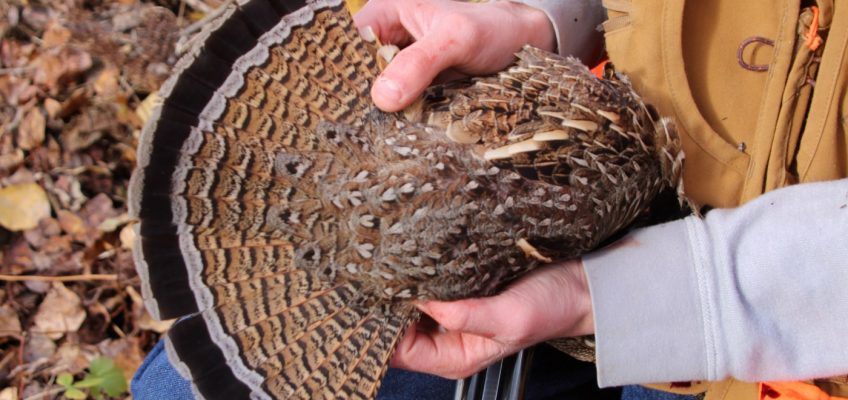BRAINERD — Minnesota upland bird hunters, the Minnesota Department of Natural Resources wants you to keep a diary this autumn of each of your hunts, keeping track of when and where you hunt, how many birds you see along the way and how many birds you bag.
And then they want you to hand over all that information to them online.
Don’t worry, no one is going to reveal or steal your favorite pheasant field or grouse woods. Instead, DNR wildlife biologists want to use the data collected from thousands of hunters to find out more about upland birds.
For many species, a single survey once a season — or in some cases, no survey at all — is the only thing wildlife managers have in hand to track the size and trend of bird populations.
Bailey Petersen and her Llewellin setter, Hatchet, with a grouse the dog pointed, flushed and retrieved in the woods northwest of Two Harbors, Minn. Petersen is part of a team of DNR wildlife biologists who have instigated an online hunter diary for upland bird hunters, hoping to gain new insights on bird populations and trends. (John Myers / Forum News Service)
“The new hunter diaries will allow upland hunters in Minnesota to provide more details into their experiences in the field, including sightings/flushes, hunt logistics as well as number of birds in the bag during the season,” Bailey Petersen, an avid upland hunter and DNR wildlife biologist in Two Harbors who helped organize the effort, told the News Tribune.
“We are hopeful this opportunity could help to better inform how upland game birds are doing beyond just our annual index surveys, as well as learn more about public perception of game bird pursuits. And it’s also just going to be fun for folks to participate in, I think.”
The DNR is asking for hunters to submit the location of where they parked their vehicle to begin their hunt, either distance and direction of the nearest town or exact GPS coordinates, said Nathaniel Huck, DNR Brainerd-based bird biologist who headed the effort.
“We aren’t going to give away anyone’s favorite spot. We can keep that private. But for this to be meaningful in any real way, we have to have a pretty precise location,” Huck said. “And we need as many hunters to participate as we can get.”
The DNR also wants to know if you were on public or private land, walking on a designated hunter walking trail, whether you had a dog along, how many hours you hunted each trip, what species you were after, how many total flushes you had (no matter why they flushed) and how many birds you bagged.
If you’re able, the DNR also wants hunters to age the birds they shoot, usually distinguishable by feathers on grouse or by the size of the spurs on a rooster pheasant, and also to determine the sex of the grouse (also using feather markings.)
Ruffed grouse are surveyed each spring by counting how often the males are heard drumming along predetermined routes in the woods. This gives a general indication of their abundance in April and May. However, the DNR has found little correlation between drumming counts and how successful hunters are months later during the hunting season.
“We really need more data on upland birds, and hunters are a great way for us to get it,” Huck said.
Related Articles
Grouse drumming up again, but downpours in June likely hurt young chicks
To save spotted owls, US officials plan to kill hundreds of thousands of another owl species
Longtime Minnesota DNR Fish and Wildlife director to retire; new director named
Minnesota, Wisconsin fall hunting seasons set — time to plan ahead
Here’s what outdoors bills passed in Minnesota this session
For example, it’s believed heavy spring rains this year may have cut into grouse and pheasant chick production. But wildlife managers have no way to confirm that until hunters step into the field.
“One of the big things we’d like to nail down is the timing of woodcock migration. We know it varies, but we don’t have good data on when it happens each year,” Huck said. “Hunters can nail that down for us pretty well.”
This is the first effort by the Minnesota DNR to capture detailed information from upland bird hunters, but Huck noted Pennsylvania and New York have used similar surveys for years.
Minnesota has about 75,000 pheasant hunters and about 60,000 grouse hunters — there is likely considerable overlap among them — down to half of those numbers at their peak a half-century ago.
The DNR is asking participants to go online after each hunt — pheasant, woodcock, ruffed grouse, sharp-tailed grouse and other upland birds — while the information is still fresh in their memory and submit a diary for that day’s efforts. If that’s not possible, you can also download a diary form and fill it out manually, then submit the data online at the end of the season. There is no provision for hunters to mail in paper diaries.
You can submit upland hunter diary reports on the 123 Survey app, which is free, or do it online. The upland hunter diary is available to the public at rb.gy/s7slxr.
Related Articles
Zebra mussels found in Lake Byllesby, Minnesota DNR says
Skywatch: Perseid meteor pleasure
Minneapolis family opens new fully accessible resort near Ely
Fort Snelling State Park reopens after June closing for floodwaters
Skywatch: Cat’s eyes of the summer skies


Leave a Reply